A Comprehensive Analysis of Motivational Theories in HRM Practices
VerifiedAdded on 2020/02/24
|13
|3976
|385
Essay
AI Summary
This essay provides a comprehensive overview of motivational theories within the context of Human Resource Management (HRM). It begins by defining motivation and its significance in strategic HRM (SHRM). The essay then delves into four key motivational theories: Maslow's Hierarchy of Needs, Hertzberg's Two-Factor Theory, McClelland's Theory of Needs (focusing on achievement, affiliation, and power), and Alderfer's ERG theory (Existence, Relatedness, and Growth). Each theory is explained with its core concepts, applications, and relevance to HRM practices. A comparative analysis of the theories is presented, highlighting their similarities, differences, and practical implications for managers. The essay also discusses the importance of understanding both intrinsic and extrinsic motivational factors. The essay concludes by emphasizing the critical role of motivation in achieving organizational goals, improving employee engagement, and fostering a positive work environment. The essay also explores the integration of these theories to provide a system for weighing the aspirations of the individual in line with the organization.

Motivational Theories in HR
1
Executive Summary
In the contemporary management practices people are important. As a result, Human
Resource Management has undergone drastic changes to adopt new approaches to its operations.
The adoption of strategic personnel management continues to revolutionize the industry.
Employees have become an integral aspect of success and performance in business organizations.
Research into this explains that there are embedded factors within individual workers that
encourage and discourage them from performing different functions. These studies point at
motivation as the ingredient for a positive outcome. This discussion is about theories that dissect
and interpret motivation as a factor of organizational best practice. It critically evaluates its use in
Strategic Human Resource Management (SHRM). Some scholars have also tried to define the
concept of motivation and its dynamics in improving performance. These studies have gone ahead
to use these approaches as prescription to diverse problems arising in personnel management. The
theories also support the existence of contemporary organizations in the cross border globalized
system. The analysis of these dimensions brings about an integrated approach of using motivational
factors in an organization.
1
Executive Summary
In the contemporary management practices people are important. As a result, Human
Resource Management has undergone drastic changes to adopt new approaches to its operations.
The adoption of strategic personnel management continues to revolutionize the industry.
Employees have become an integral aspect of success and performance in business organizations.
Research into this explains that there are embedded factors within individual workers that
encourage and discourage them from performing different functions. These studies point at
motivation as the ingredient for a positive outcome. This discussion is about theories that dissect
and interpret motivation as a factor of organizational best practice. It critically evaluates its use in
Strategic Human Resource Management (SHRM). Some scholars have also tried to define the
concept of motivation and its dynamics in improving performance. These studies have gone ahead
to use these approaches as prescription to diverse problems arising in personnel management. The
theories also support the existence of contemporary organizations in the cross border globalized
system. The analysis of these dimensions brings about an integrated approach of using motivational
factors in an organization.
Paraphrase This Document
Need a fresh take? Get an instant paraphrase of this document with our AI Paraphraser
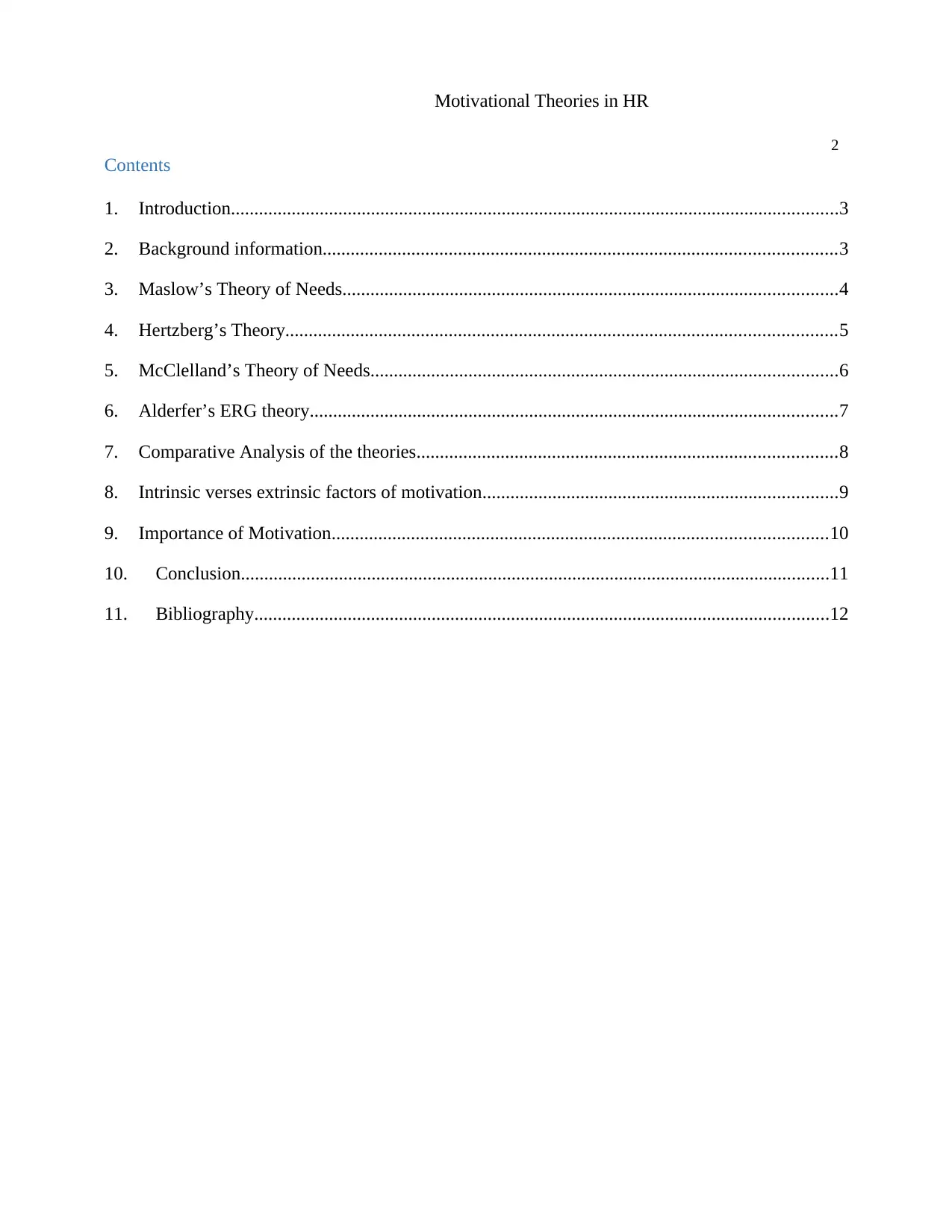
Motivational Theories in HR
2
Contents
1. Introduction..................................................................................................................................3
2. Background information..............................................................................................................3
3. Maslow’s Theory of Needs..........................................................................................................4
4. Hertzberg’s Theory......................................................................................................................5
5. McClelland’s Theory of Needs....................................................................................................6
6. Alderfer’s ERG theory.................................................................................................................7
7. Comparative Analysis of the theories..........................................................................................8
8. Intrinsic verses extrinsic factors of motivation............................................................................9
9. Importance of Motivation..........................................................................................................10
10. Conclusion..............................................................................................................................11
11. Bibliography...........................................................................................................................12
2
Contents
1. Introduction..................................................................................................................................3
2. Background information..............................................................................................................3
3. Maslow’s Theory of Needs..........................................................................................................4
4. Hertzberg’s Theory......................................................................................................................5
5. McClelland’s Theory of Needs....................................................................................................6
6. Alderfer’s ERG theory.................................................................................................................7
7. Comparative Analysis of the theories..........................................................................................8
8. Intrinsic verses extrinsic factors of motivation............................................................................9
9. Importance of Motivation..........................................................................................................10
10. Conclusion..............................................................................................................................11
11. Bibliography...........................................................................................................................12
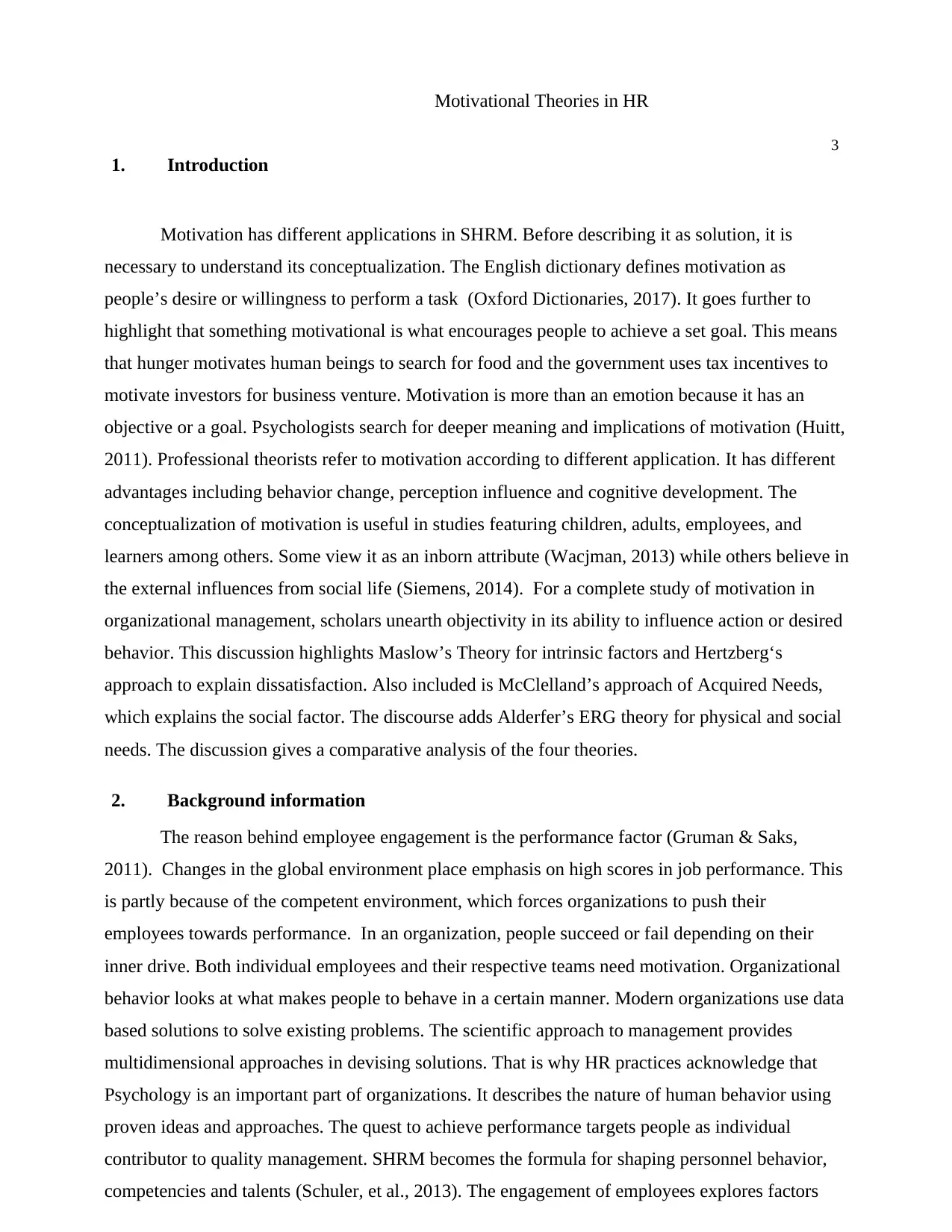
Motivational Theories in HR
3
1. Introduction
Motivation has different applications in SHRM. Before describing it as solution, it is
necessary to understand its conceptualization. The English dictionary defines motivation as
people’s desire or willingness to perform a task (Oxford Dictionaries, 2017). It goes further to
highlight that something motivational is what encourages people to achieve a set goal. This means
that hunger motivates human beings to search for food and the government uses tax incentives to
motivate investors for business venture. Motivation is more than an emotion because it has an
objective or a goal. Psychologists search for deeper meaning and implications of motivation (Huitt,
2011). Professional theorists refer to motivation according to different application. It has different
advantages including behavior change, perception influence and cognitive development. The
conceptualization of motivation is useful in studies featuring children, adults, employees, and
learners among others. Some view it as an inborn attribute (Wacjman, 2013) while others believe in
the external influences from social life (Siemens, 2014). For a complete study of motivation in
organizational management, scholars unearth objectivity in its ability to influence action or desired
behavior. This discussion highlights Maslow’s Theory for intrinsic factors and Hertzberg‘s
approach to explain dissatisfaction. Also included is McClelland’s approach of Acquired Needs,
which explains the social factor. The discourse adds Alderfer’s ERG theory for physical and social
needs. The discussion gives a comparative analysis of the four theories.
2. Background information
The reason behind employee engagement is the performance factor (Gruman & Saks,
2011). Changes in the global environment place emphasis on high scores in job performance. This
is partly because of the competent environment, which forces organizations to push their
employees towards performance. In an organization, people succeed or fail depending on their
inner drive. Both individual employees and their respective teams need motivation. Organizational
behavior looks at what makes people to behave in a certain manner. Modern organizations use data
based solutions to solve existing problems. The scientific approach to management provides
multidimensional approaches in devising solutions. That is why HR practices acknowledge that
Psychology is an important part of organizations. It describes the nature of human behavior using
proven ideas and approaches. The quest to achieve performance targets people as individual
contributor to quality management. SHRM becomes the formula for shaping personnel behavior,
competencies and talents (Schuler, et al., 2013). The engagement of employees explores factors
3
1. Introduction
Motivation has different applications in SHRM. Before describing it as solution, it is
necessary to understand its conceptualization. The English dictionary defines motivation as
people’s desire or willingness to perform a task (Oxford Dictionaries, 2017). It goes further to
highlight that something motivational is what encourages people to achieve a set goal. This means
that hunger motivates human beings to search for food and the government uses tax incentives to
motivate investors for business venture. Motivation is more than an emotion because it has an
objective or a goal. Psychologists search for deeper meaning and implications of motivation (Huitt,
2011). Professional theorists refer to motivation according to different application. It has different
advantages including behavior change, perception influence and cognitive development. The
conceptualization of motivation is useful in studies featuring children, adults, employees, and
learners among others. Some view it as an inborn attribute (Wacjman, 2013) while others believe in
the external influences from social life (Siemens, 2014). For a complete study of motivation in
organizational management, scholars unearth objectivity in its ability to influence action or desired
behavior. This discussion highlights Maslow’s Theory for intrinsic factors and Hertzberg‘s
approach to explain dissatisfaction. Also included is McClelland’s approach of Acquired Needs,
which explains the social factor. The discourse adds Alderfer’s ERG theory for physical and social
needs. The discussion gives a comparative analysis of the four theories.
2. Background information
The reason behind employee engagement is the performance factor (Gruman & Saks,
2011). Changes in the global environment place emphasis on high scores in job performance. This
is partly because of the competent environment, which forces organizations to push their
employees towards performance. In an organization, people succeed or fail depending on their
inner drive. Both individual employees and their respective teams need motivation. Organizational
behavior looks at what makes people to behave in a certain manner. Modern organizations use data
based solutions to solve existing problems. The scientific approach to management provides
multidimensional approaches in devising solutions. That is why HR practices acknowledge that
Psychology is an important part of organizations. It describes the nature of human behavior using
proven ideas and approaches. The quest to achieve performance targets people as individual
contributor to quality management. SHRM becomes the formula for shaping personnel behavior,
competencies and talents (Schuler, et al., 2013). The engagement of employees explores factors
⊘ This is a preview!⊘
Do you want full access?
Subscribe today to unlock all pages.

Trusted by 1+ million students worldwide
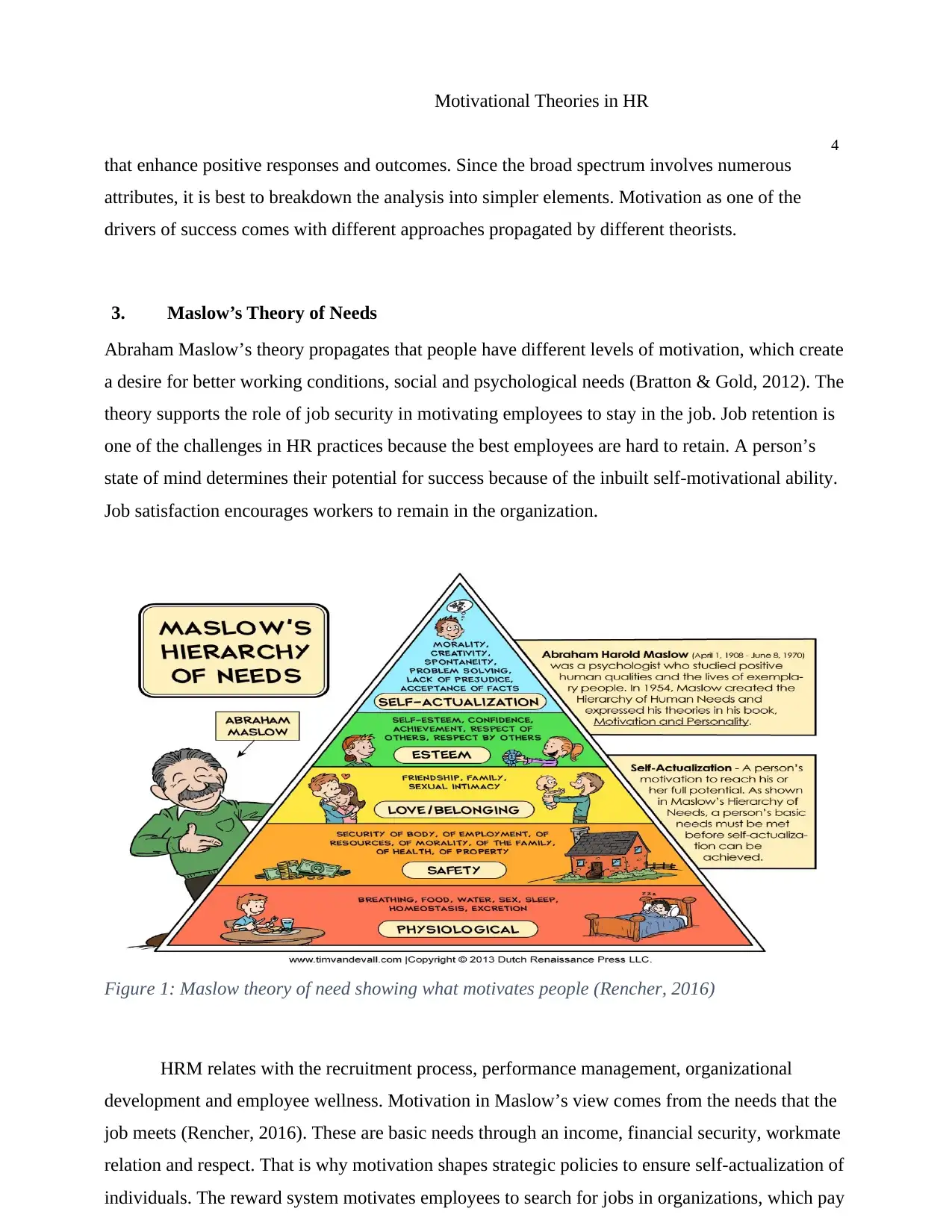
Motivational Theories in HR
4
that enhance positive responses and outcomes. Since the broad spectrum involves numerous
attributes, it is best to breakdown the analysis into simpler elements. Motivation as one of the
drivers of success comes with different approaches propagated by different theorists.
3. Maslow’s Theory of Needs
Abraham Maslow’s theory propagates that people have different levels of motivation, which create
a desire for better working conditions, social and psychological needs (Bratton & Gold, 2012). The
theory supports the role of job security in motivating employees to stay in the job. Job retention is
one of the challenges in HR practices because the best employees are hard to retain. A person’s
state of mind determines their potential for success because of the inbuilt self-motivational ability.
Job satisfaction encourages workers to remain in the organization.
Figure 1: Maslow theory of need showing what motivates people (Rencher, 2016)
HRM relates with the recruitment process, performance management, organizational
development and employee wellness. Motivation in Maslow’s view comes from the needs that the
job meets (Rencher, 2016). These are basic needs through an income, financial security, workmate
relation and respect. That is why motivation shapes strategic policies to ensure self-actualization of
individuals. The reward system motivates employees to search for jobs in organizations, which pay
4
that enhance positive responses and outcomes. Since the broad spectrum involves numerous
attributes, it is best to breakdown the analysis into simpler elements. Motivation as one of the
drivers of success comes with different approaches propagated by different theorists.
3. Maslow’s Theory of Needs
Abraham Maslow’s theory propagates that people have different levels of motivation, which create
a desire for better working conditions, social and psychological needs (Bratton & Gold, 2012). The
theory supports the role of job security in motivating employees to stay in the job. Job retention is
one of the challenges in HR practices because the best employees are hard to retain. A person’s
state of mind determines their potential for success because of the inbuilt self-motivational ability.
Job satisfaction encourages workers to remain in the organization.
Figure 1: Maslow theory of need showing what motivates people (Rencher, 2016)
HRM relates with the recruitment process, performance management, organizational
development and employee wellness. Motivation in Maslow’s view comes from the needs that the
job meets (Rencher, 2016). These are basic needs through an income, financial security, workmate
relation and respect. That is why motivation shapes strategic policies to ensure self-actualization of
individuals. The reward system motivates employees to search for jobs in organizations, which pay
Paraphrase This Document
Need a fresh take? Get an instant paraphrase of this document with our AI Paraphraser

Motivational Theories in HR
5
well. Companies that have the best skilled have better pay and tactics to retain their workers.
Among these is talent development, which attracts professionals searching for growth and
development opportunities. Maslow’s theory supports job security and a work environment that is
has good interpersonal relationships. People have social and psychological needs. The monetary
allowances and promotions satisfy their ego and emotional contentment. Self-actualization is the
higher need, which serves as a boost to self-esteem (Vance, et al., 2012).
4. Hertzberg’s Theory
Employees get dissatisfaction from the work environment. This includes lack of safety,
compensation and working conditions. Fredrick Hertzberg discusses the two-factor theory that
points towards job satisfaction and job dissatisfaction. In support of Maslow’s approach, this
approach agrees that motivation comes shapes certain attitudes and comes from needs. However, it
adds that discontent comes from lack of these satisfaction influencers. When employees leave after
training in an organization, the reason could be the desire for better terms of employment, a salary
increase or work safety. Therefore, the suggestion is that organizations need strategies for jobs
satisfaction as well as those that hinder dissatisfied employees (Hertberg, et al., 2011).
Hertzberg motivation advises managers to create a working that motivates employees such
as working conditions and opportunities for growth. Enlisting hygiene factors as those supporting
the work environment, he compares them with motivation factors (Latham, 2012). Figure 2 below
summarizes this. For example, the quality of supervision encourages workers to pursue promotions
and better opportunities. This means low-level workers has the courage to request for a job
upgrade. Company policies also encourage or discourage workers from aiming high. Sometimes
professionals prefer working in the government sector because of the job security. People who
prefer to start their own businesses do so for achievement and better income.
5
well. Companies that have the best skilled have better pay and tactics to retain their workers.
Among these is talent development, which attracts professionals searching for growth and
development opportunities. Maslow’s theory supports job security and a work environment that is
has good interpersonal relationships. People have social and psychological needs. The monetary
allowances and promotions satisfy their ego and emotional contentment. Self-actualization is the
higher need, which serves as a boost to self-esteem (Vance, et al., 2012).
4. Hertzberg’s Theory
Employees get dissatisfaction from the work environment. This includes lack of safety,
compensation and working conditions. Fredrick Hertzberg discusses the two-factor theory that
points towards job satisfaction and job dissatisfaction. In support of Maslow’s approach, this
approach agrees that motivation comes shapes certain attitudes and comes from needs. However, it
adds that discontent comes from lack of these satisfaction influencers. When employees leave after
training in an organization, the reason could be the desire for better terms of employment, a salary
increase or work safety. Therefore, the suggestion is that organizations need strategies for jobs
satisfaction as well as those that hinder dissatisfied employees (Hertberg, et al., 2011).
Hertzberg motivation advises managers to create a working that motivates employees such
as working conditions and opportunities for growth. Enlisting hygiene factors as those supporting
the work environment, he compares them with motivation factors (Latham, 2012). Figure 2 below
summarizes this. For example, the quality of supervision encourages workers to pursue promotions
and better opportunities. This means low-level workers has the courage to request for a job
upgrade. Company policies also encourage or discourage workers from aiming high. Sometimes
professionals prefer working in the government sector because of the job security. People who
prefer to start their own businesses do so for achievement and better income.
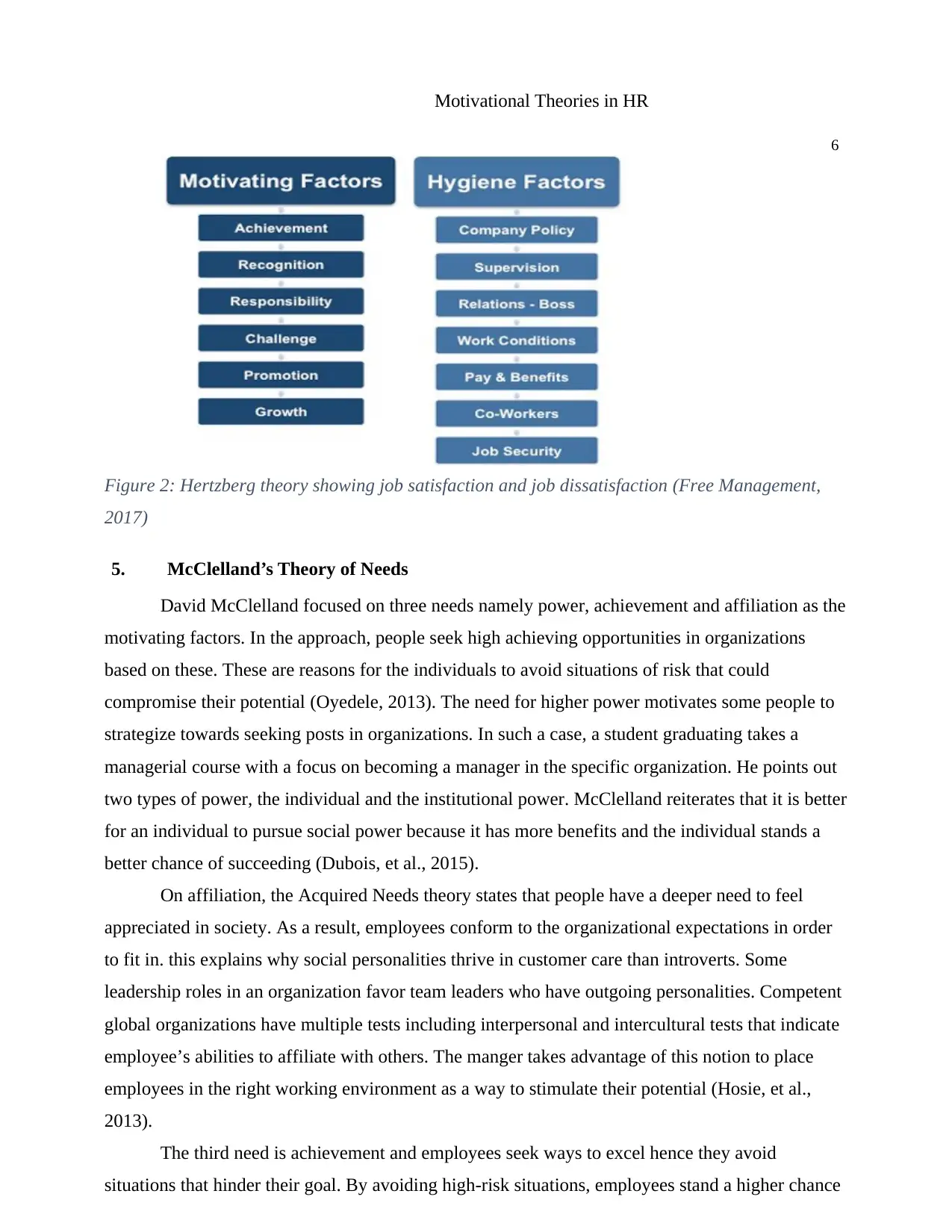
Motivational Theories in HR
6
Figure 2: Hertzberg theory showing job satisfaction and job dissatisfaction (Free Management,
2017)
5. McClelland’s Theory of Needs
David McClelland focused on three needs namely power, achievement and affiliation as the
motivating factors. In the approach, people seek high achieving opportunities in organizations
based on these. These are reasons for the individuals to avoid situations of risk that could
compromise their potential (Oyedele, 2013). The need for higher power motivates some people to
strategize towards seeking posts in organizations. In such a case, a student graduating takes a
managerial course with a focus on becoming a manager in the specific organization. He points out
two types of power, the individual and the institutional power. McClelland reiterates that it is better
for an individual to pursue social power because it has more benefits and the individual stands a
better chance of succeeding (Dubois, et al., 2015).
On affiliation, the Acquired Needs theory states that people have a deeper need to feel
appreciated in society. As a result, employees conform to the organizational expectations in order
to fit in. this explains why social personalities thrive in customer care than introverts. Some
leadership roles in an organization favor team leaders who have outgoing personalities. Competent
global organizations have multiple tests including interpersonal and intercultural tests that indicate
employee’s abilities to affiliate with others. The manger takes advantage of this notion to place
employees in the right working environment as a way to stimulate their potential (Hosie, et al.,
2013).
The third need is achievement and employees seek ways to excel hence they avoid
situations that hinder their goal. By avoiding high-risk situations, employees stand a higher chance
6
Figure 2: Hertzberg theory showing job satisfaction and job dissatisfaction (Free Management,
2017)
5. McClelland’s Theory of Needs
David McClelland focused on three needs namely power, achievement and affiliation as the
motivating factors. In the approach, people seek high achieving opportunities in organizations
based on these. These are reasons for the individuals to avoid situations of risk that could
compromise their potential (Oyedele, 2013). The need for higher power motivates some people to
strategize towards seeking posts in organizations. In such a case, a student graduating takes a
managerial course with a focus on becoming a manager in the specific organization. He points out
two types of power, the individual and the institutional power. McClelland reiterates that it is better
for an individual to pursue social power because it has more benefits and the individual stands a
better chance of succeeding (Dubois, et al., 2015).
On affiliation, the Acquired Needs theory states that people have a deeper need to feel
appreciated in society. As a result, employees conform to the organizational expectations in order
to fit in. this explains why social personalities thrive in customer care than introverts. Some
leadership roles in an organization favor team leaders who have outgoing personalities. Competent
global organizations have multiple tests including interpersonal and intercultural tests that indicate
employee’s abilities to affiliate with others. The manger takes advantage of this notion to place
employees in the right working environment as a way to stimulate their potential (Hosie, et al.,
2013).
The third need is achievement and employees seek ways to excel hence they avoid
situations that hinder their goal. By avoiding high-risk situations, employees stand a higher chance
⊘ This is a preview!⊘
Do you want full access?
Subscribe today to unlock all pages.

Trusted by 1+ million students worldwide
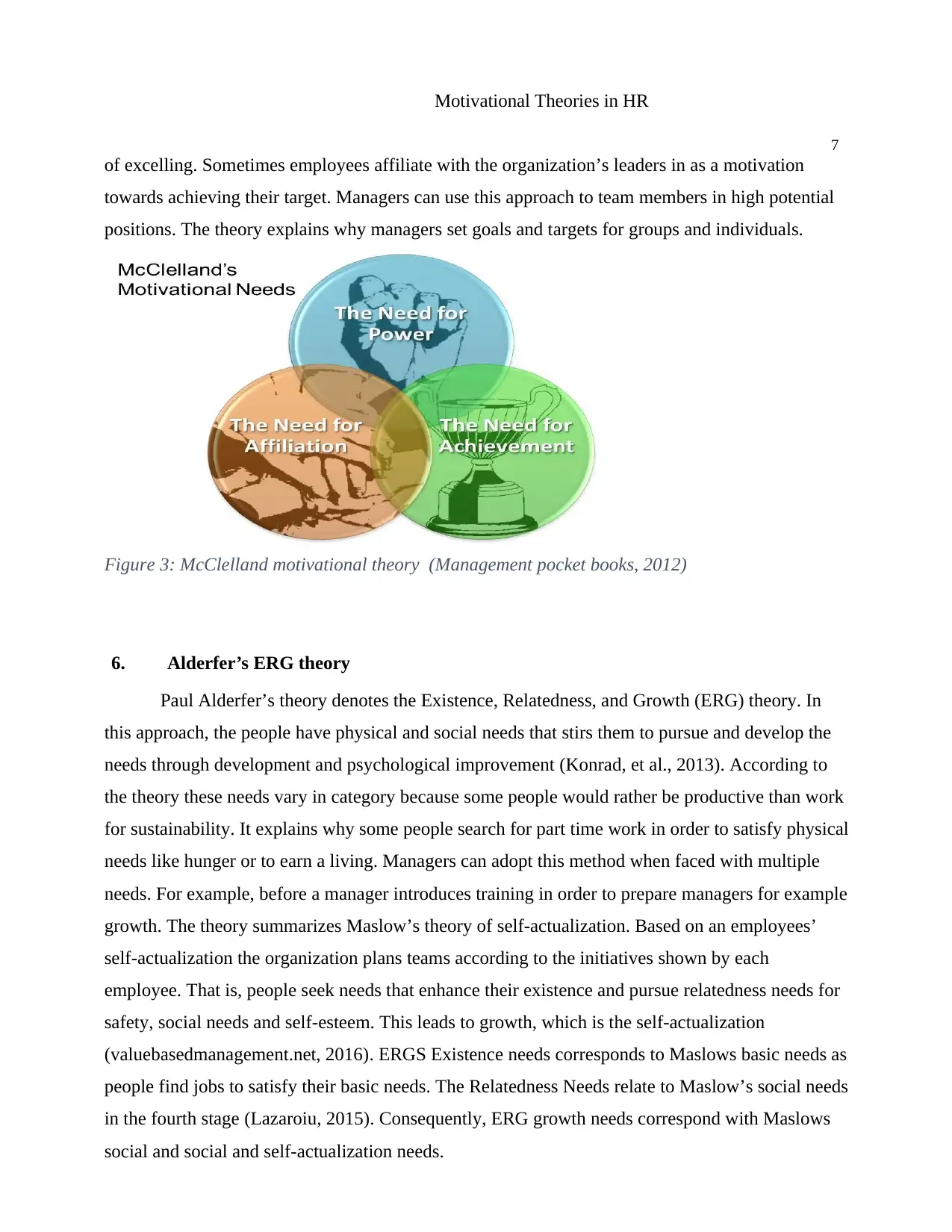
Motivational Theories in HR
7
of excelling. Sometimes employees affiliate with the organization’s leaders in as a motivation
towards achieving their target. Managers can use this approach to team members in high potential
positions. The theory explains why managers set goals and targets for groups and individuals.
Figure 3: McClelland motivational theory (Management pocket books, 2012)
6. Alderfer’s ERG theory
Paul Alderfer’s theory denotes the Existence, Relatedness, and Growth (ERG) theory. In
this approach, the people have physical and social needs that stirs them to pursue and develop the
needs through development and psychological improvement (Konrad, et al., 2013). According to
the theory these needs vary in category because some people would rather be productive than work
for sustainability. It explains why some people search for part time work in order to satisfy physical
needs like hunger or to earn a living. Managers can adopt this method when faced with multiple
needs. For example, before a manager introduces training in order to prepare managers for example
growth. The theory summarizes Maslow’s theory of self-actualization. Based on an employees’
self-actualization the organization plans teams according to the initiatives shown by each
employee. That is, people seek needs that enhance their existence and pursue relatedness needs for
safety, social needs and self-esteem. This leads to growth, which is the self-actualization
(valuebasedmanagement.net, 2016). ERGS Existence needs corresponds to Maslows basic needs as
people find jobs to satisfy their basic needs. The Relatedness Needs relate to Maslow’s social needs
in the fourth stage (Lazaroiu, 2015). Consequently, ERG growth needs correspond with Maslows
social and social and self-actualization needs.
7
of excelling. Sometimes employees affiliate with the organization’s leaders in as a motivation
towards achieving their target. Managers can use this approach to team members in high potential
positions. The theory explains why managers set goals and targets for groups and individuals.
Figure 3: McClelland motivational theory (Management pocket books, 2012)
6. Alderfer’s ERG theory
Paul Alderfer’s theory denotes the Existence, Relatedness, and Growth (ERG) theory. In
this approach, the people have physical and social needs that stirs them to pursue and develop the
needs through development and psychological improvement (Konrad, et al., 2013). According to
the theory these needs vary in category because some people would rather be productive than work
for sustainability. It explains why some people search for part time work in order to satisfy physical
needs like hunger or to earn a living. Managers can adopt this method when faced with multiple
needs. For example, before a manager introduces training in order to prepare managers for example
growth. The theory summarizes Maslow’s theory of self-actualization. Based on an employees’
self-actualization the organization plans teams according to the initiatives shown by each
employee. That is, people seek needs that enhance their existence and pursue relatedness needs for
safety, social needs and self-esteem. This leads to growth, which is the self-actualization
(valuebasedmanagement.net, 2016). ERGS Existence needs corresponds to Maslows basic needs as
people find jobs to satisfy their basic needs. The Relatedness Needs relate to Maslow’s social needs
in the fourth stage (Lazaroiu, 2015). Consequently, ERG growth needs correspond with Maslows
social and social and self-actualization needs.
Paraphrase This Document
Need a fresh take? Get an instant paraphrase of this document with our AI Paraphraser
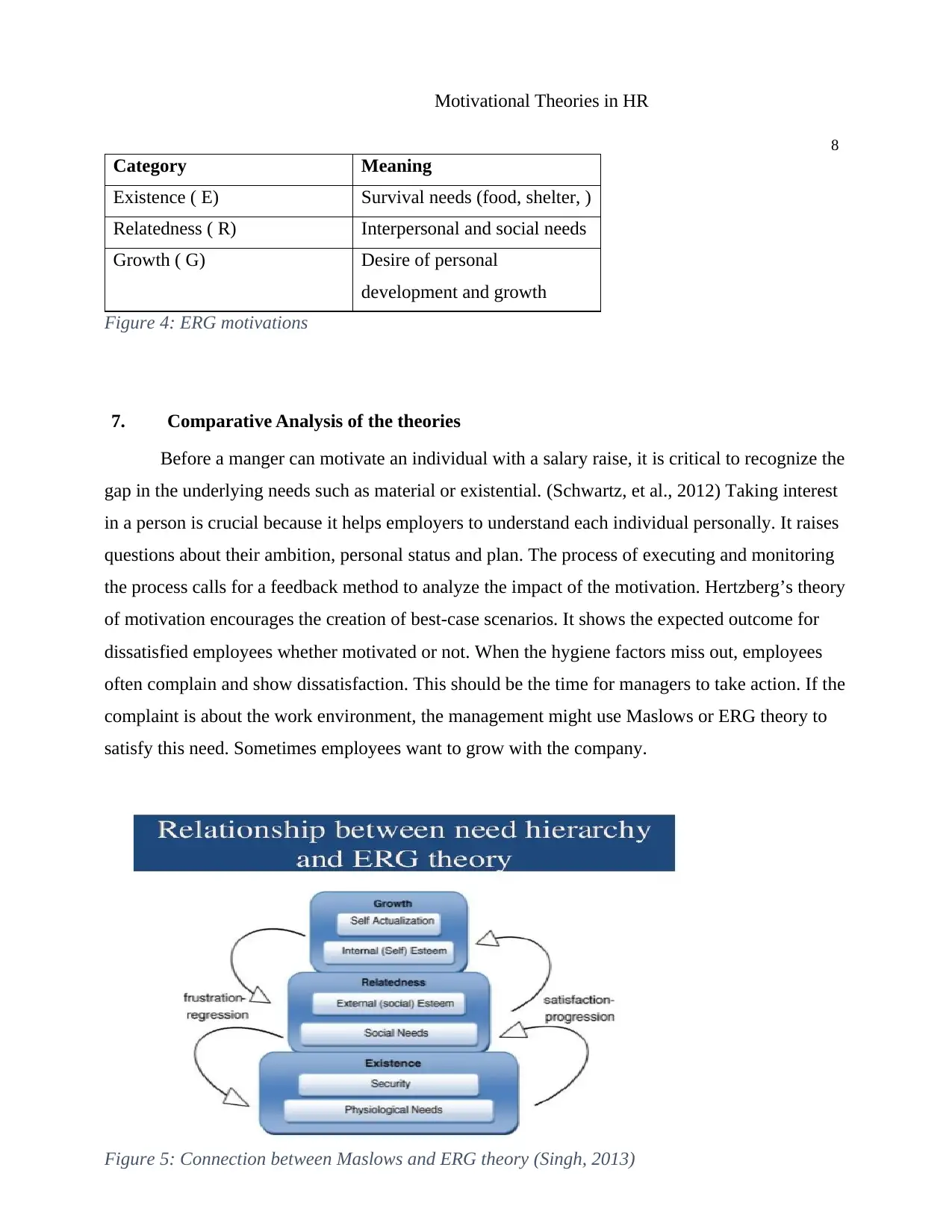
Motivational Theories in HR
8
Category Meaning
Existence ( E) Survival needs (food, shelter, )
Relatedness ( R) Interpersonal and social needs
Growth ( G) Desire of personal
development and growth
Figure 4: ERG motivations
7. Comparative Analysis of the theories
Before a manger can motivate an individual with a salary raise, it is critical to recognize the
gap in the underlying needs such as material or existential. (Schwartz, et al., 2012) Taking interest
in a person is crucial because it helps employers to understand each individual personally. It raises
questions about their ambition, personal status and plan. The process of executing and monitoring
the process calls for a feedback method to analyze the impact of the motivation. Hertzberg’s theory
of motivation encourages the creation of best-case scenarios. It shows the expected outcome for
dissatisfied employees whether motivated or not. When the hygiene factors miss out, employees
often complain and show dissatisfaction. This should be the time for managers to take action. If the
complaint is about the work environment, the management might use Maslows or ERG theory to
satisfy this need. Sometimes employees want to grow with the company.
Figure 5: Connection between Maslows and ERG theory (Singh, 2013)
8
Category Meaning
Existence ( E) Survival needs (food, shelter, )
Relatedness ( R) Interpersonal and social needs
Growth ( G) Desire of personal
development and growth
Figure 4: ERG motivations
7. Comparative Analysis of the theories
Before a manger can motivate an individual with a salary raise, it is critical to recognize the
gap in the underlying needs such as material or existential. (Schwartz, et al., 2012) Taking interest
in a person is crucial because it helps employers to understand each individual personally. It raises
questions about their ambition, personal status and plan. The process of executing and monitoring
the process calls for a feedback method to analyze the impact of the motivation. Hertzberg’s theory
of motivation encourages the creation of best-case scenarios. It shows the expected outcome for
dissatisfied employees whether motivated or not. When the hygiene factors miss out, employees
often complain and show dissatisfaction. This should be the time for managers to take action. If the
complaint is about the work environment, the management might use Maslows or ERG theory to
satisfy this need. Sometimes employees want to grow with the company.
Figure 5: Connection between Maslows and ERG theory (Singh, 2013)
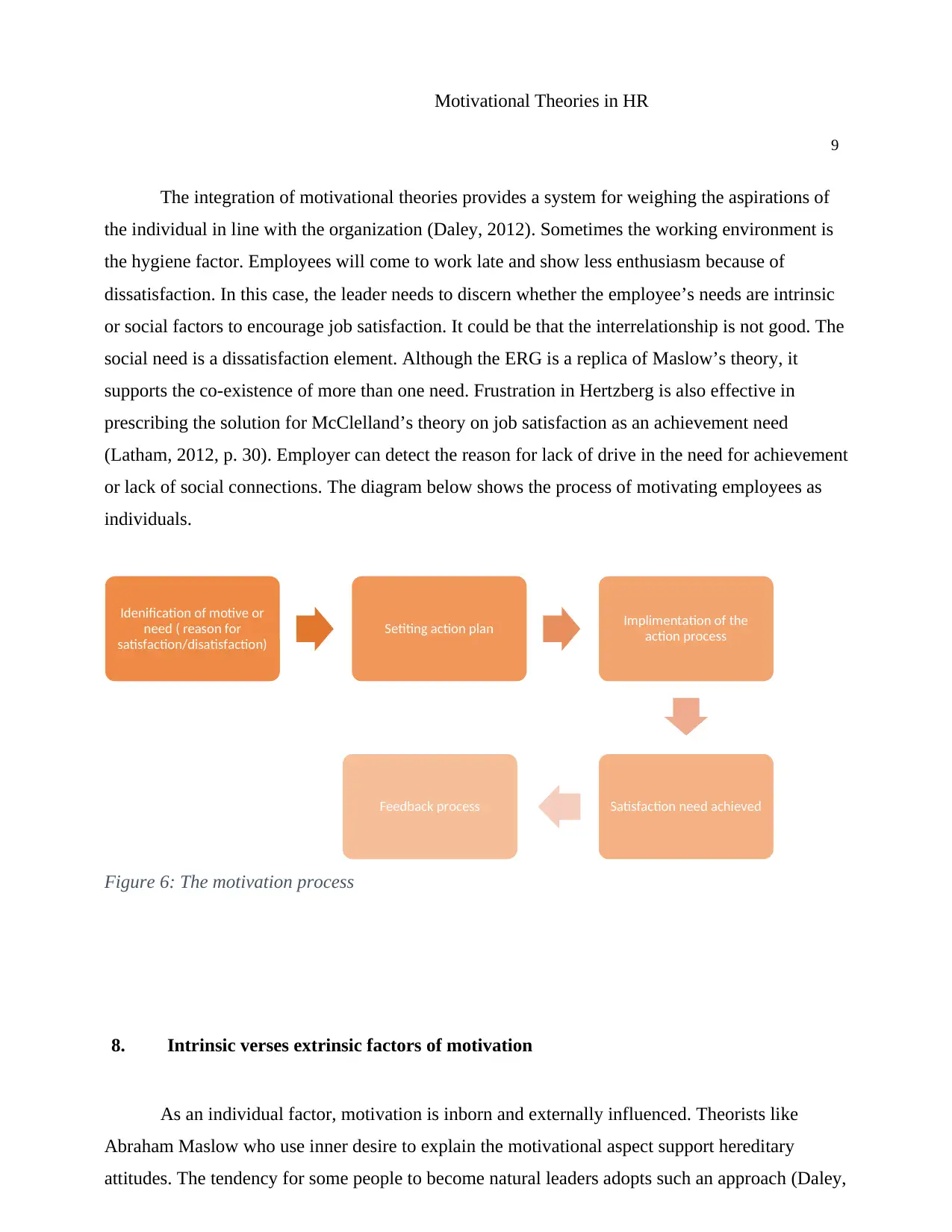
Motivational Theories in HR
9
The integration of motivational theories provides a system for weighing the aspirations of
the individual in line with the organization (Daley, 2012). Sometimes the working environment is
the hygiene factor. Employees will come to work late and show less enthusiasm because of
dissatisfaction. In this case, the leader needs to discern whether the employee’s needs are intrinsic
or social factors to encourage job satisfaction. It could be that the interrelationship is not good. The
social need is a dissatisfaction element. Although the ERG is a replica of Maslow’s theory, it
supports the co-existence of more than one need. Frustration in Hertzberg is also effective in
prescribing the solution for McClelland’s theory on job satisfaction as an achievement need
(Latham, 2012, p. 30). Employer can detect the reason for lack of drive in the need for achievement
or lack of social connections. The diagram below shows the process of motivating employees as
individuals.
Figure 6: The motivation process
8. Intrinsic verses extrinsic factors of motivation
As an individual factor, motivation is inborn and externally influenced. Theorists like
Abraham Maslow who use inner desire to explain the motivational aspect support hereditary
attitudes. The tendency for some people to become natural leaders adopts such an approach (Daley,
Idenification of motive or
need ( reason for
satisfaction/disatisfaction)
Setiting action plan Implimentation of the
action process
Satisfaction need achievedFeedback process
9
The integration of motivational theories provides a system for weighing the aspirations of
the individual in line with the organization (Daley, 2012). Sometimes the working environment is
the hygiene factor. Employees will come to work late and show less enthusiasm because of
dissatisfaction. In this case, the leader needs to discern whether the employee’s needs are intrinsic
or social factors to encourage job satisfaction. It could be that the interrelationship is not good. The
social need is a dissatisfaction element. Although the ERG is a replica of Maslow’s theory, it
supports the co-existence of more than one need. Frustration in Hertzberg is also effective in
prescribing the solution for McClelland’s theory on job satisfaction as an achievement need
(Latham, 2012, p. 30). Employer can detect the reason for lack of drive in the need for achievement
or lack of social connections. The diagram below shows the process of motivating employees as
individuals.
Figure 6: The motivation process
8. Intrinsic verses extrinsic factors of motivation
As an individual factor, motivation is inborn and externally influenced. Theorists like
Abraham Maslow who use inner desire to explain the motivational aspect support hereditary
attitudes. The tendency for some people to become natural leaders adopts such an approach (Daley,
Idenification of motive or
need ( reason for
satisfaction/disatisfaction)
Setiting action plan Implimentation of the
action process
Satisfaction need achievedFeedback process
⊘ This is a preview!⊘
Do you want full access?
Subscribe today to unlock all pages.

Trusted by 1+ million students worldwide
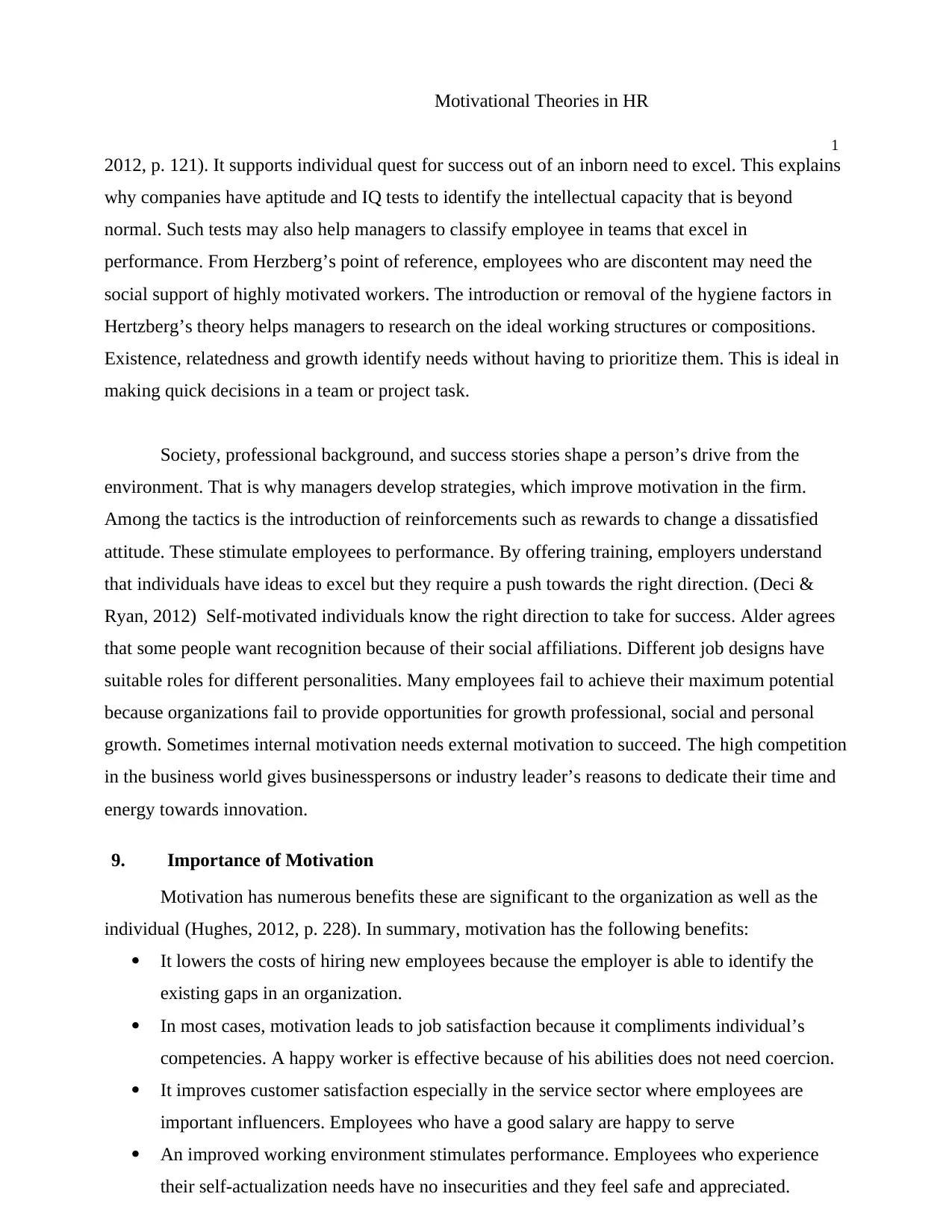
Motivational Theories in HR
1
02012, p. 121). It supports individual quest for success out of an inborn need to excel. This explains
why companies have aptitude and IQ tests to identify the intellectual capacity that is beyond
normal. Such tests may also help managers to classify employee in teams that excel in
performance. From Herzberg’s point of reference, employees who are discontent may need the
social support of highly motivated workers. The introduction or removal of the hygiene factors in
Hertzberg’s theory helps managers to research on the ideal working structures or compositions.
Existence, relatedness and growth identify needs without having to prioritize them. This is ideal in
making quick decisions in a team or project task.
Society, professional background, and success stories shape a person’s drive from the
environment. That is why managers develop strategies, which improve motivation in the firm.
Among the tactics is the introduction of reinforcements such as rewards to change a dissatisfied
attitude. These stimulate employees to performance. By offering training, employers understand
that individuals have ideas to excel but they require a push towards the right direction. (Deci &
Ryan, 2012) Self-motivated individuals know the right direction to take for success. Alder agrees
that some people want recognition because of their social affiliations. Different job designs have
suitable roles for different personalities. Many employees fail to achieve their maximum potential
because organizations fail to provide opportunities for growth professional, social and personal
growth. Sometimes internal motivation needs external motivation to succeed. The high competition
in the business world gives businesspersons or industry leader’s reasons to dedicate their time and
energy towards innovation.
9. Importance of Motivation
Motivation has numerous benefits these are significant to the organization as well as the
individual (Hughes, 2012, p. 228). In summary, motivation has the following benefits:
It lowers the costs of hiring new employees because the employer is able to identify the
existing gaps in an organization.
In most cases, motivation leads to job satisfaction because it compliments individual’s
competencies. A happy worker is effective because of his abilities does not need coercion.
It improves customer satisfaction especially in the service sector where employees are
important influencers. Employees who have a good salary are happy to serve
An improved working environment stimulates performance. Employees who experience
their self-actualization needs have no insecurities and they feel safe and appreciated.
1
02012, p. 121). It supports individual quest for success out of an inborn need to excel. This explains
why companies have aptitude and IQ tests to identify the intellectual capacity that is beyond
normal. Such tests may also help managers to classify employee in teams that excel in
performance. From Herzberg’s point of reference, employees who are discontent may need the
social support of highly motivated workers. The introduction or removal of the hygiene factors in
Hertzberg’s theory helps managers to research on the ideal working structures or compositions.
Existence, relatedness and growth identify needs without having to prioritize them. This is ideal in
making quick decisions in a team or project task.
Society, professional background, and success stories shape a person’s drive from the
environment. That is why managers develop strategies, which improve motivation in the firm.
Among the tactics is the introduction of reinforcements such as rewards to change a dissatisfied
attitude. These stimulate employees to performance. By offering training, employers understand
that individuals have ideas to excel but they require a push towards the right direction. (Deci &
Ryan, 2012) Self-motivated individuals know the right direction to take for success. Alder agrees
that some people want recognition because of their social affiliations. Different job designs have
suitable roles for different personalities. Many employees fail to achieve their maximum potential
because organizations fail to provide opportunities for growth professional, social and personal
growth. Sometimes internal motivation needs external motivation to succeed. The high competition
in the business world gives businesspersons or industry leader’s reasons to dedicate their time and
energy towards innovation.
9. Importance of Motivation
Motivation has numerous benefits these are significant to the organization as well as the
individual (Hughes, 2012, p. 228). In summary, motivation has the following benefits:
It lowers the costs of hiring new employees because the employer is able to identify the
existing gaps in an organization.
In most cases, motivation leads to job satisfaction because it compliments individual’s
competencies. A happy worker is effective because of his abilities does not need coercion.
It improves customer satisfaction especially in the service sector where employees are
important influencers. Employees who have a good salary are happy to serve
An improved working environment stimulates performance. Employees who experience
their self-actualization needs have no insecurities and they feel safe and appreciated.
Paraphrase This Document
Need a fresh take? Get an instant paraphrase of this document with our AI Paraphraser
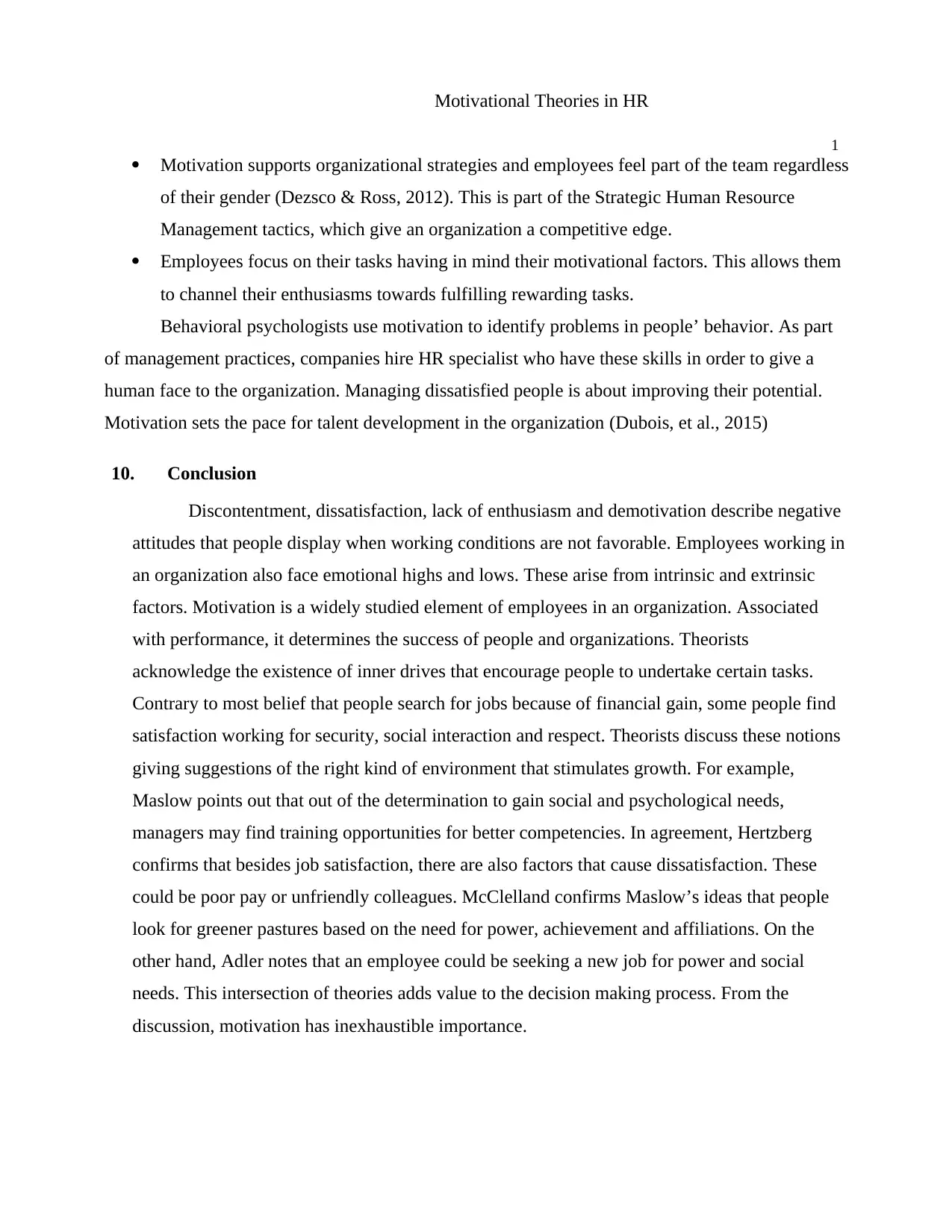
Motivational Theories in HR
1
1 Motivation supports organizational strategies and employees feel part of the team regardless
of their gender (Dezsco & Ross, 2012). This is part of the Strategic Human Resource
Management tactics, which give an organization a competitive edge.
Employees focus on their tasks having in mind their motivational factors. This allows them
to channel their enthusiasms towards fulfilling rewarding tasks.
Behavioral psychologists use motivation to identify problems in people’ behavior. As part
of management practices, companies hire HR specialist who have these skills in order to give a
human face to the organization. Managing dissatisfied people is about improving their potential.
Motivation sets the pace for talent development in the organization (Dubois, et al., 2015)
10. Conclusion
Discontentment, dissatisfaction, lack of enthusiasm and demotivation describe negative
attitudes that people display when working conditions are not favorable. Employees working in
an organization also face emotional highs and lows. These arise from intrinsic and extrinsic
factors. Motivation is a widely studied element of employees in an organization. Associated
with performance, it determines the success of people and organizations. Theorists
acknowledge the existence of inner drives that encourage people to undertake certain tasks.
Contrary to most belief that people search for jobs because of financial gain, some people find
satisfaction working for security, social interaction and respect. Theorists discuss these notions
giving suggestions of the right kind of environment that stimulates growth. For example,
Maslow points out that out of the determination to gain social and psychological needs,
managers may find training opportunities for better competencies. In agreement, Hertzberg
confirms that besides job satisfaction, there are also factors that cause dissatisfaction. These
could be poor pay or unfriendly colleagues. McClelland confirms Maslow’s ideas that people
look for greener pastures based on the need for power, achievement and affiliations. On the
other hand, Adler notes that an employee could be seeking a new job for power and social
needs. This intersection of theories adds value to the decision making process. From the
discussion, motivation has inexhaustible importance.
1
1 Motivation supports organizational strategies and employees feel part of the team regardless
of their gender (Dezsco & Ross, 2012). This is part of the Strategic Human Resource
Management tactics, which give an organization a competitive edge.
Employees focus on their tasks having in mind their motivational factors. This allows them
to channel their enthusiasms towards fulfilling rewarding tasks.
Behavioral psychologists use motivation to identify problems in people’ behavior. As part
of management practices, companies hire HR specialist who have these skills in order to give a
human face to the organization. Managing dissatisfied people is about improving their potential.
Motivation sets the pace for talent development in the organization (Dubois, et al., 2015)
10. Conclusion
Discontentment, dissatisfaction, lack of enthusiasm and demotivation describe negative
attitudes that people display when working conditions are not favorable. Employees working in
an organization also face emotional highs and lows. These arise from intrinsic and extrinsic
factors. Motivation is a widely studied element of employees in an organization. Associated
with performance, it determines the success of people and organizations. Theorists
acknowledge the existence of inner drives that encourage people to undertake certain tasks.
Contrary to most belief that people search for jobs because of financial gain, some people find
satisfaction working for security, social interaction and respect. Theorists discuss these notions
giving suggestions of the right kind of environment that stimulates growth. For example,
Maslow points out that out of the determination to gain social and psychological needs,
managers may find training opportunities for better competencies. In agreement, Hertzberg
confirms that besides job satisfaction, there are also factors that cause dissatisfaction. These
could be poor pay or unfriendly colleagues. McClelland confirms Maslow’s ideas that people
look for greener pastures based on the need for power, achievement and affiliations. On the
other hand, Adler notes that an employee could be seeking a new job for power and social
needs. This intersection of theories adds value to the decision making process. From the
discussion, motivation has inexhaustible importance.
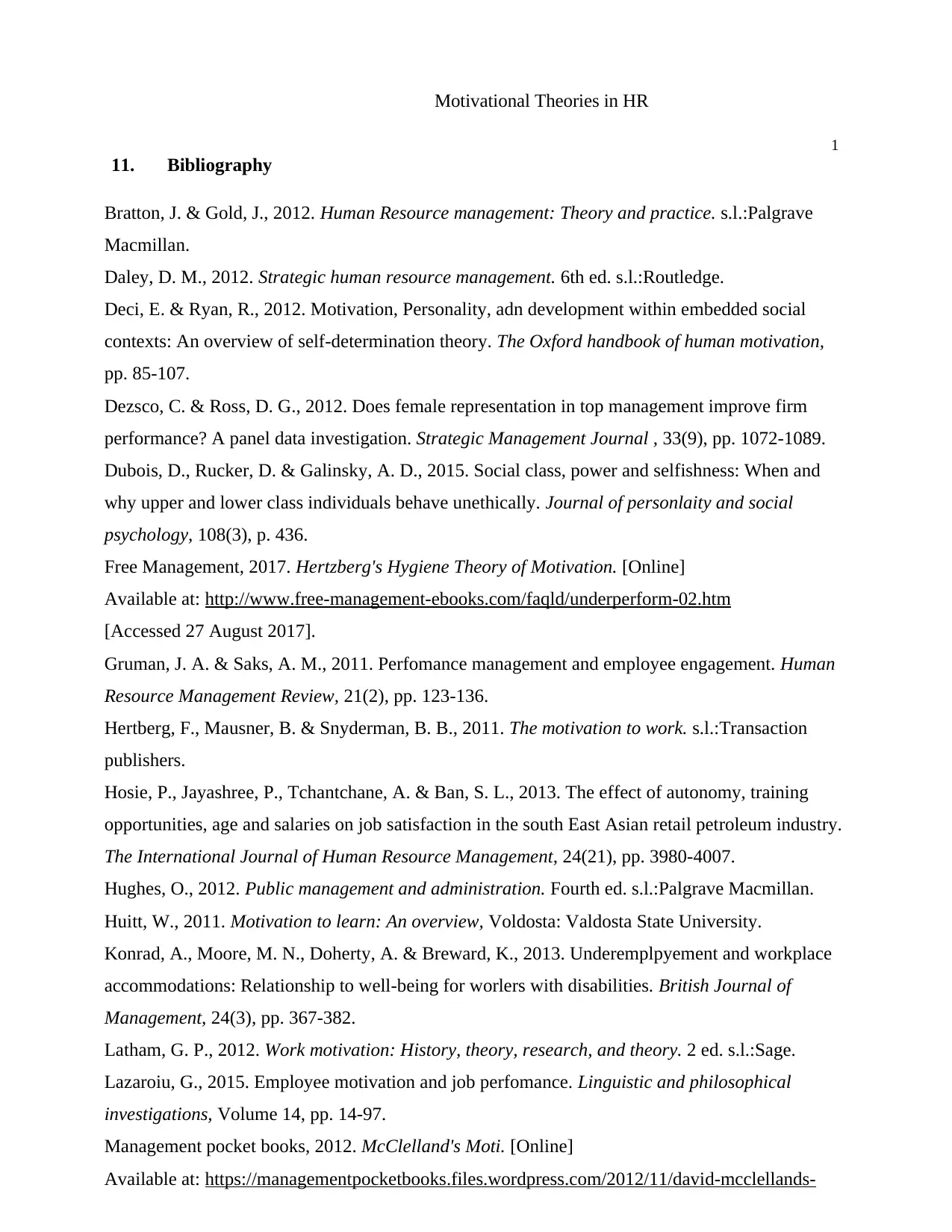
Motivational Theories in HR
1
211. Bibliography
Bratton, J. & Gold, J., 2012. Human Resource management: Theory and practice. s.l.:Palgrave
Macmillan.
Daley, D. M., 2012. Strategic human resource management. 6th ed. s.l.:Routledge.
Deci, E. & Ryan, R., 2012. Motivation, Personality, adn development within embedded social
contexts: An overview of self-determination theory. The Oxford handbook of human motivation,
pp. 85-107.
Dezsco, C. & Ross, D. G., 2012. Does female representation in top management improve firm
performance? A panel data investigation. Strategic Management Journal , 33(9), pp. 1072-1089.
Dubois, D., Rucker, D. & Galinsky, A. D., 2015. Social class, power and selfishness: When and
why upper and lower class individuals behave unethically. Journal of personlaity and social
psychology, 108(3), p. 436.
Free Management, 2017. Hertzberg's Hygiene Theory of Motivation. [Online]
Available at: http://www.free-management-ebooks.com/faqld/underperform-02.htm
[Accessed 27 August 2017].
Gruman, J. A. & Saks, A. M., 2011. Perfomance management and employee engagement. Human
Resource Management Review, 21(2), pp. 123-136.
Hertberg, F., Mausner, B. & Snyderman, B. B., 2011. The motivation to work. s.l.:Transaction
publishers.
Hosie, P., Jayashree, P., Tchantchane, A. & Ban, S. L., 2013. The effect of autonomy, training
opportunities, age and salaries on job satisfaction in the south East Asian retail petroleum industry.
The International Journal of Human Resource Management, 24(21), pp. 3980-4007.
Hughes, O., 2012. Public management and administration. Fourth ed. s.l.:Palgrave Macmillan.
Huitt, W., 2011. Motivation to learn: An overview, Voldosta: Valdosta State University.
Konrad, A., Moore, M. N., Doherty, A. & Breward, K., 2013. Underemplpyement and workplace
accommodations: Relationship to well-being for worlers with disabilities. British Journal of
Management, 24(3), pp. 367-382.
Latham, G. P., 2012. Work motivation: History, theory, research, and theory. 2 ed. s.l.:Sage.
Lazaroiu, G., 2015. Employee motivation and job perfomance. Linguistic and philosophical
investigations, Volume 14, pp. 14-97.
Management pocket books, 2012. McClelland's Moti. [Online]
Available at: https://managementpocketbooks.files.wordpress.com/2012/11/david-mcclellands-
1
211. Bibliography
Bratton, J. & Gold, J., 2012. Human Resource management: Theory and practice. s.l.:Palgrave
Macmillan.
Daley, D. M., 2012. Strategic human resource management. 6th ed. s.l.:Routledge.
Deci, E. & Ryan, R., 2012. Motivation, Personality, adn development within embedded social
contexts: An overview of self-determination theory. The Oxford handbook of human motivation,
pp. 85-107.
Dezsco, C. & Ross, D. G., 2012. Does female representation in top management improve firm
performance? A panel data investigation. Strategic Management Journal , 33(9), pp. 1072-1089.
Dubois, D., Rucker, D. & Galinsky, A. D., 2015. Social class, power and selfishness: When and
why upper and lower class individuals behave unethically. Journal of personlaity and social
psychology, 108(3), p. 436.
Free Management, 2017. Hertzberg's Hygiene Theory of Motivation. [Online]
Available at: http://www.free-management-ebooks.com/faqld/underperform-02.htm
[Accessed 27 August 2017].
Gruman, J. A. & Saks, A. M., 2011. Perfomance management and employee engagement. Human
Resource Management Review, 21(2), pp. 123-136.
Hertberg, F., Mausner, B. & Snyderman, B. B., 2011. The motivation to work. s.l.:Transaction
publishers.
Hosie, P., Jayashree, P., Tchantchane, A. & Ban, S. L., 2013. The effect of autonomy, training
opportunities, age and salaries on job satisfaction in the south East Asian retail petroleum industry.
The International Journal of Human Resource Management, 24(21), pp. 3980-4007.
Hughes, O., 2012. Public management and administration. Fourth ed. s.l.:Palgrave Macmillan.
Huitt, W., 2011. Motivation to learn: An overview, Voldosta: Valdosta State University.
Konrad, A., Moore, M. N., Doherty, A. & Breward, K., 2013. Underemplpyement and workplace
accommodations: Relationship to well-being for worlers with disabilities. British Journal of
Management, 24(3), pp. 367-382.
Latham, G. P., 2012. Work motivation: History, theory, research, and theory. 2 ed. s.l.:Sage.
Lazaroiu, G., 2015. Employee motivation and job perfomance. Linguistic and philosophical
investigations, Volume 14, pp. 14-97.
Management pocket books, 2012. McClelland's Moti. [Online]
Available at: https://managementpocketbooks.files.wordpress.com/2012/11/david-mcclellands-
⊘ This is a preview!⊘
Do you want full access?
Subscribe today to unlock all pages.

Trusted by 1+ million students worldwide
1 out of 13
Related Documents
Your All-in-One AI-Powered Toolkit for Academic Success.
+13062052269
info@desklib.com
Available 24*7 on WhatsApp / Email
![[object Object]](/_next/static/media/star-bottom.7253800d.svg)
Unlock your academic potential
Copyright © 2020–2025 A2Z Services. All Rights Reserved. Developed and managed by ZUCOL.





